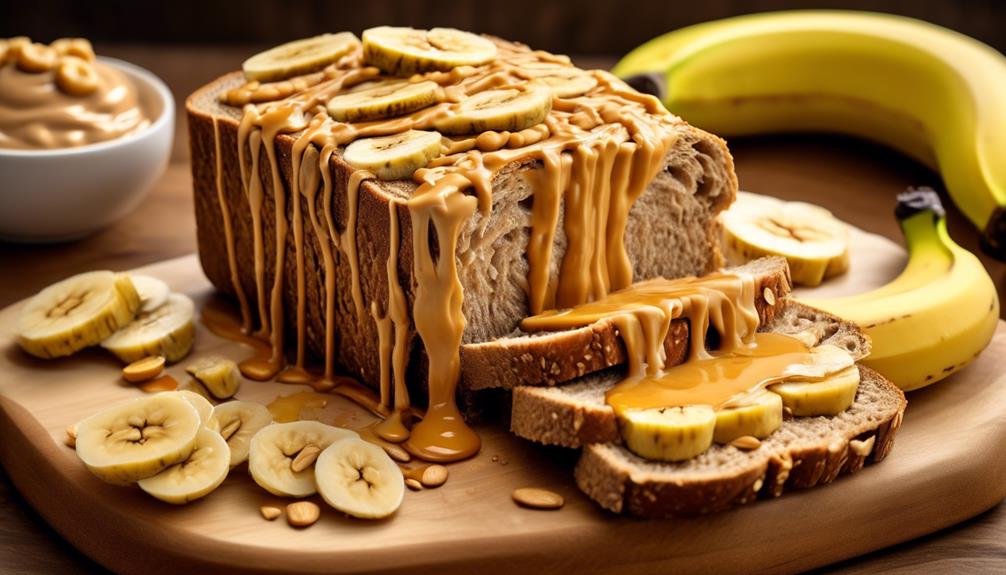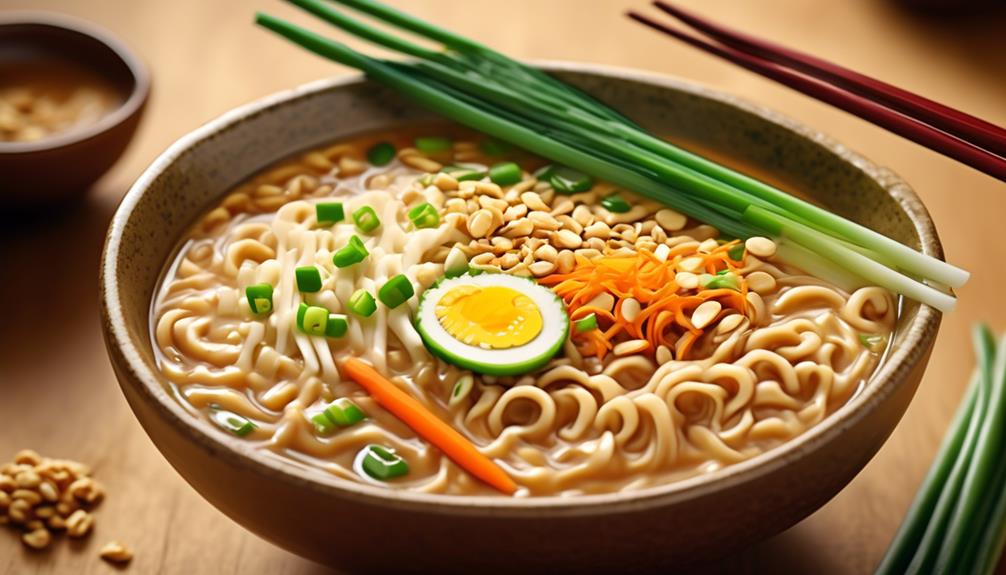So, have you ever found yourself wondering why peanut butter can sometimes be dry and difficult to spread? It's a common issue that many of us have encountered, and there are a few key factors that contribute to this frustrating texture.
Understanding these reasons can help us appreciate the complexity of this beloved spread and perhaps even find some solutions to ensure a smoother, creamier experience.
Key Takeaways
- Stirring the separated oil back into peanut butter helps maintain smoothness and prevent dryness.
- Adding neutral oil or refined peanut oil can improve the texture of dry peanut butter.
- Storing peanut butter upside down or stirring it regularly helps prevent oil separation and maintain moisture.
- Natural peanut butter may have a coarser texture and drier consistency compared to processed peanut butter.
Peanut Butter Consistency
Consistently stirring the separated oil back into the peanut butter before use is essential for achieving a smooth and integrated consistency. This process ensures that the natural oils present in the peanuts are evenly distributed throughout the butter, preventing the formation of a dry and crumbly texture.
For larger quantities of peanut butter, especially when making it at home, incorporating a few drops of neutral oil and using a food processor can bring the nut butter to life, improving its texture and mouthfeel.
Additionally, experimenting with peanuts from different sources may also affect the overall consistency of the peanut butter. Furthermore, adding a couple of spoons of refined peanut oil to homemade peanut butter can significantly enhance its texture, making it easier to consume.
Understanding these factors and techniques is crucial in maintaining the desired smoothness and spreadability of peanut butter, ensuring a delightful and consistent experience with every use.
Moisture Content in Peanut Butter

Peanut butter's low water content, approximately 2%, contributes to its inherently dry nature compared to other food products. This low moisture content is a result of the peanuts being ground into a paste, removing much of the natural oils and water.
To address the moisture content in peanut butter, there are several factors to consider:
- Ingredients in store-bought peanut butter often include added sugar, salt, and emulsifiers, which not only enhance the taste but also contribute to a smoother texture, making it less dry.
- Adding neutral oil, such as vegetable or coconut oil, to dry and crumbly peanut butter can improve its moisture content and texture, resulting in a creamier consistency.
- When making homemade peanut butter, the type of peanuts used can significantly affect the texture. Peanuts with a higher oil content will yield a creamier consistency, while using a high-powered blender or food processor can result in a smoother and creamier texture. To achieve a creamier homemade peanut butter, it's essential to make sure the equipment used is capable of thoroughly grinding the peanuts to release their natural oils.
The Role of Oil in Peanut Butter

Considering the low moisture content in peanut butter as a result of the grinding process, the role of oil becomes crucial in maintaining and enhancing its texture and consistency.
When the peanut butter is made, the natural oils in the peanuts are released during the grinding process. These oils play a vital role in determining the spreadability and mouthfeel of the peanut butter.
Stirring the jar or storing it upside down helps to ensure that the oil is well-distributed throughout the peanut butter, preventing it from becoming dry and crumbly.
Additionally, adding a few drops of neutral oil or refined peanut oil can help revive and improve the texture of dry peanut butter, making it smoother and creamier.
Heating the jar in warm water can also assist in loosening up the peanut butter and achieving a smoother consistency.
Oxidation Process in Peanut Butter

Oxidation in peanut butter occurs as the unsaturated fats in peanuts react with oxygen from the air, leading to rancidity and dryness. This chemical process alters the flavor, aroma, and texture of the peanut butter, making it less appealing.
To mitigate this, consider the following tips:
- Stir the Peanut Butter: Especially when newly opened, stirring the jar helps distribute the oil and prevent the top layer from becoming dry and crumbly.
- Invert the Jar: Storing the peanut butter jar upside down can help prevent oil separation and maintain moisture throughout the jar, reducing the impact of oxidation.
- Add Neutral Oil: Incorporating neutral oil, such as peanut oil, can help hydrate and revitalize dry and crumbly peanut butter, particularly when preparing it at home.
Understanding the oxidation process in peanut butter allows us to take practical steps to maintain its freshness and texture. By implementing these measures, we can prolong the shelf life and enjoy the full, creamy texture of peanut butter, enhancing the overall culinary experience.
Impact of Storage Conditions

Storing peanut butter in a cool, dry environment can significantly impact its texture and shelf life. The way we store our peanut butter can make a big difference in its overall consistency and spreadability.
For instance, keeping the jar upside down can help prevent the formation of a dry, crumbly layer, as the oil sinks to the bottom and keeps the butter well-hydrated at the top. Additionally, stirring in neutral oil or adding a few drops of water and gently heating the jar in warm water can revive dry and crumbly nut butter, providing alternative methods for achieving a smooth consistency.
It's important to note that homemade peanut butter may lack certain added ingredients, like sugar, salt, and emulsifiers, which can result in a drier consistency compared to store-bought peanut butter. However, adding refined peanut oil to homemade peanut butter can improve its texture, making it easier to consume and closer in consistency to store-bought peanut butter.
Peanut Butter Additives

Let's examine the effects of additives on peanut butter moisture absorption.
Understanding how additives like oils, sweeteners, and stabilizers impact the texture and moisture levels can provide valuable insights into combating dryness.
Additive Effects
When considering the impact of peanut butter additives, it's essential to prioritize natural options without added emulsifiers or stabilizers to minimize additive effects and maintain optimal texture.
In addition to choosing natural peanut butter, a few simple techniques can also help mitigate the effects of additives and maintain a desirable texture:
- Storage Technique: Storing the jar upside down can prevent the formation of a dry, crumbly layer by evenly distributing the oil.
- Oil Addition: Adding a few drops of neutral oil to dry and crumbly peanut butter can improve its texture and provide a smoother consistency.
- Ingredient Comparison: Comparing the ingredients list of store-bought peanut butter with homemade peanut butter can reveal differences in texture due to added ingredients like sugar, salt, and emulsifiers.
Moisture Absorption
Moisture absorption in peanut butter, influenced by additives, plays a crucial role in determining its texture and consistency. Here's a table summarizing the impact of various methods on maintaining moisture in peanut butter:
| Method | Impact |
|---|---|
| Stirring the jar | Integrates separated oil, achieving a smoother consistency. |
| Storing upside down | Prevents the formation of a dry, crumbly layer, keeping peanut butter well-hydrated. |
| Adding neutral oil | Incorporates moisture, improving texture. Using a food processor ensures thorough blending. |
| Heating the jar | Loosens up dry peanut butter, providing an alternative method for achieving a smoother consistency. |
| Store-bought vs Homemade Peanut Butter | Store-bought often contains added ingredients for better texture, while homemade may lack these, resulting in a drier consistency. |
Natural Vs. Processed Peanut Butter

When comparing natural and processed peanut butter, it's crucial to understand the impact of ingredients on texture and consistency.
The absence of added sugar, salt, and emulsifiers in natural peanut butter can result in a drier and less creamy product.
Additionally, the separation of natural peanut butter requires stirring, whereas processed varieties often contain stabilizers to maintain a uniform texture.
Ingredients in Natural PB
In natural peanut butter, the ingredients typically consist of only peanuts and sometimes salt, distinguishing it from processed peanut butter which may contain added sugar, salt, and emulsifiers for enhanced taste and texture. The simplicity of natural peanut butter's ingredients offers a purer and more wholesome option compared to its processed counterpart.
Here are a few key differences in the ingredients of natural peanut butter:
- Separation: Natural peanut butter often separates, with the oil rising to the top, while processed versions have added stabilizers to prevent separation.
- Oils: Processed peanut butter may contain hydrogenated oils or palm oil, while natural peanut butter relies solely on the natural oils from the peanuts.
- Additives: Natural peanut butter is free from artificial preservatives and additives, reflecting a simpler, more straightforward composition that enhances its nutritional value.
These distinctions highlight the nutritional and compositional disparities between natural and processed peanut butter.
Processing Affects Texture
The processing method significantly impacts the texture of peanut butter, distinguishing natural from processed varieties.
Natural peanut butter, made from just peanuts and salt, tends to have a coarser texture due to the absence of added stabilizers. The oil separation in natural peanut butter can lead to a drier consistency, requiring thorough stirring or storage upside down to maintain a smoother texture.
On the other hand, processed peanut butter often contains added hydrogenated oils and emulsifiers to create a creamier, more uniform texture that stays consistent throughout the jar. The addition of these ingredients helps prevent the separation of oil, resulting in a smoother and less dry texture.
Understanding these differences in processing can help consumers choose the type of peanut butter that best suits their texture preferences.
Oil Separation in PB
Understanding the impact of oil separation in peanut butter is crucial for distinguishing the textural differences between natural and processed varieties, particularly in relation to their production and ingredient composition.
- Natural Peanut Butter
- The oil rises to the top, resulting in a need to stir the jar thoroughly to achieve a smoother consistency.
- Storing the jar upside down can help redistribute the oil, preventing the formation of a dry, crumbly layer at the top.
- Adding a few drops of neutral oil and thoroughly stirring can hydrate the butter and enhance its texture.
- Processed Peanut Butter
- Typically contains added emulsifiers to prevent oil separation.
- Offers a consistent texture without the need for manual mixing.
- May contain additional ingredients like sugar and salt, affecting its overall composition and texture.
Understanding these differences can help consumers make informed choices based on their texture and ingredient preferences.
Nutritional Impact of Dry Peanut Butter

Examining the nutritional impact of dry peanut butter reveals its altered composition and potential implications for dietary intake. When peanut butter becomes dry, its nutritional profile may change, impacting its overall health benefits. The table below compares the nutritional content of regular peanut butter with that of dry peanut butter to demonstrate the potential differences in key nutrients.
| Nutrient | Regular Peanut Butter | Dry Peanut Butter |
|---|---|---|
| Protein | 25g | 25g |
| Fat | 16g | 16g |
| Carbohydrates | 6g | 6g |
| Fiber | 2g | 2g |
| Added Sugar/Salt | May contain | May lack |
Despite the similar macronutrient content, dry peanut butter may lack added sugar and salt often found in regular peanut butter. This can be advantageous for those seeking to reduce their intake of these additives. However, the dryness might impact the overall palatability and texture, potentially affecting consumer preference and satisfaction. Additionally, the altered composition of dry peanut butter could influence its digestibility and absorption of nutrients. Therefore, while dry peanut butter may offer certain nutritional benefits, its overall impact on dietary intake warrants careful consideration.
Factors Affecting Creaminess

When it comes to the creaminess of peanut butter, several key factors play a significant role. These include:
- The process of stirring the jar to integrate the separated oil
- Storing the jar upside down to maintain hydration
- The option of adding neutral oil to achieve a smoother texture
Additionally, the impact of storage conditions and the differences between store-bought and homemade peanut butter on the overall creaminess should be carefully considered.
Oil Separation
Stirring the jar of nut butter thoroughly with a knife is a practical method for integrating the oil and achieving a smooth, creamy consistency.
Additionally, storing the jar upside down prevents the formation of a dry, crumbly layer and allows the oil to sink to the bottom for a well-hydrated texture.
Another useful tip is to stir in neutral oil or add a few drops to dry and crumbly nut butter, using a food processor for larger amounts to fully incorporate the oil.
Heating the jar by placing it in warm water or adding a few drops of water can also help to loosen up the nut butter.
These methods, when employed properly, can effectively address oil separation in nut butter, ensuring a consistently creamy texture that enhances the overall eating experience.
Storage Conditions
To maintain optimal creaminess in nut butter, proper storage conditions play a crucial role in preserving its texture and quality. Stirring the jar to integrate the separated oil into the nuts is essential for achieving a smooth consistency.
Additionally, storing the jar upside down can prevent the formation of a dry, crumbly layer and ensure well-hydrated nut butter.
In cases where the nut butter becomes dry and crumbly, incorporating a few drops of neutral oil and fully blending it in, especially for larger amounts using a food processor, can help revive the texture. Moreover, gently heating the jar in warm water can also help achieve a smooth consistency.
It's important to note that making nut butter at home is a viable option and that proper storage is essential for maintaining its texture.
Preventing Dryness in Peanut Butter

One effective method for preventing dryness in peanut butter involves storing it in a cool, dark place to maintain its moisture content. Additionally, it's important to keep the lid tightly sealed to prevent air from entering the jar and causing the peanut butter to dry out.
Another key strategy is to consume the peanut butter within a reasonable timeframe to avoid extended exposure to air, which can lead to moisture loss.
Tips for Preventing Dryness in Peanut Butter:
- Proper Storage: Store peanut butter in a cool, dark place to maintain its moisture content. Ensure the lid is tightly sealed to prevent air from entering the jar.
- Timely Consumption: Consume the peanut butter within a reasonable timeframe to minimize extended exposure to air, which can lead to moisture loss.
- Avoid Refrigeration: While refrigeration can prevent oil separation, it can also cause the peanut butter to harden. Therefore, it's best to store peanut butter at room temperature for optimal texture and moisture retention.
Tips for Reviving Dry Peanut Butter

Rehydrating dry peanut butter can be achieved by incorporating a small amount of oil and thoroughly mixing it to restore its creamy consistency. When faced with dry peanut butter, it's essential to choose the right type of oil to reintroduce moisture. Opt for neutral oils such as vegetable or canola oil, as they won't overpower the peanut flavor. Start by adding a teaspoon of oil to the dry peanut butter and mix it thoroughly. Gradually add more oil if needed, but be cautious not to overdo it, as too much oil can make the peanut butter too runny.
Another effective method is using a food processor or blender to revive dry peanut butter. Simply add the dry peanut butter and a small amount of oil into the processor and blend until the desired consistency is achieved. This method not only rehydrates the peanut butter but also ensures a smooth and uniform texture.
It's important to note that once the peanut butter has been rehydrated, it should be consumed promptly or stored properly to prevent it from drying out again. Keep it in an airtight container in a cool, dry place to maintain its revived creamy texture.
Spreading Dry Peanut Butter

After addressing the methods for rehydrating dry peanut butter, the next crucial aspect is how to effectively spread the reconstituted peanut butter onto various surfaces. When dealing with dry peanut butter, spreading it can be a bit challenging. Here are some tips to help you spread dry peanut butter effectively:
- Warm it up: Gently heating the reconstituted peanut butter can make it easier to spread. A few seconds in the microwave or some time sitting in a warm water bath can help soften the peanut butter and make it more spreadable.
- Use a thin layer: Instead of trying to spread a thick layer of peanut butter, opt for a thinner layer. This can reduce the resistance and make it easier to spread evenly.
- Choose the right tool: Using a spatula or a butter knife with a thin, flexible blade can make spreading dry peanut butter much easier. These tools allow for better control and smoother application.
Peanut Butter Shelf Life

To ensure the longevity of peanut butter, it's essential to consider factors such as proper storage and the impact of added ingredients on its shelf life.
Peanut butter, when stored in a cool, dry place and sealed tightly, can generally last for several months. However, the presence of added ingredients, such as sugar or hydrogenated oils, can affect its shelf life. These ingredients can contribute to a shorter shelf life due to their impact on the overall stability of the peanut butter.
Additionally, exposure to air and moisture can lead to rancidity, affecting the taste and quality of the peanut butter over time. It's important to note that natural peanut butter, without added stabilizers, may have a shorter shelf life compared to commercially produced peanut butter.
Therefore, it's crucial to read the label and follow any specific storage instructions provided. By understanding the impact of added ingredients and proper storage techniques, consumers can better manage the shelf life of their peanut butter and ensure its quality over time.
Frequently Asked Questions
How Do You Make Peanut Butter Less Dry?
We can make peanut butter less dry by:
- stirring the jar to integrate the separated oil,
- storing it upside down to keep the top layer well-hydrated with oil,
- adding a few drops of neutral oil and fully incorporating it, or
- heating the jar in warm water to loosen up the butter.
These methods ensure a smoother, more spreadable consistency.
It's important to store nut butter properly and experiment with homemade recipes for optimal texture.
How Do You Fix Dried Peanut Butter?
When peanut butter dries out, we can revive it by adding a bit of oil and stirring it gently. The oil helps to restore the creamy texture and makes it easier to spread.
Another method is to microwave the peanut butter for a few seconds to soften it up.
Both of these techniques help to bring back the smooth, delicious consistency that we all love in peanut butter.
How Do You Keep Peanut Butter Moist?
To keep peanut butter moist, we store the jar upside down to keep the oil well-hydrated throughout the nut butter.
If it becomes dry and crumbly, we add a few drops of neutral oil and fully incorporate it with a knife or food processor.
Heating the jar in warm water can also help achieve a smoother consistency.
Experimenting with peanuts with higher oil content or adding honey, cocoa powder, or powdered sugar can improve texture and flavor.
What Causes Peanut Butter to Harden?
Peanut butter can harden due to the natural separation of oils from the nuts. This process, called oil separation, causes the peanut butter to become dry and crumbly. To prevent this, stir the separated oil back in and store the jar upside down.
Adding a few drops of neutral oil or water can also help maintain a smoother consistency. Store-bought options with added ingredients like emulsifiers tend to have a softer texture than homemade peanut butter.
Conclusion
In conclusion, the dryness of peanut butter can be attributed to factors such as oil separation, added ingredients, and storage conditions.
Understanding the moisture content, role of oil, and oxidation process is crucial in preventing dryness and extending shelf life.
By incorporating these tips and techniques, we can ensure that our peanut butter remains creamy and spreadable, coincidentally enhancing our overall enjoyment of this beloved pantry staple.










